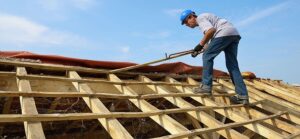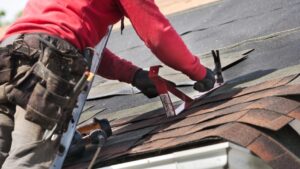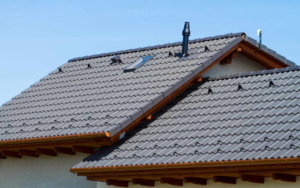
Your roof is one of the most important parts of your home, protecting you from the elements and ensuring your family’s safety. Proper maintenance and regular inspections can prevent costly repairs and extend the lifespan of your roof, whether you have shingles, metal, or tile. In this guide, we’ll cover expert tips on maintaining and inspecting different roofing types to keep your home secure year-round.
General Roof Maintenance Tips
Routine Cleaning and Debris Removal
- Clear leaves, branches, and dirt from the roof and gutters.
- Trim overhanging tree branches to prevent damage.
Checking for Leaks and Water Damage
- Look for water stains on ceilings and walls.
- Inspect attic insulation for moisture buildup.
Proper Gutter Maintenance
- Clean gutters regularly to prevent clogging.
- Ensure downspouts direct water away from the foundation.
Shingle Roof Maintenance
Common Issues with Shingles
- Curling, cracking, or missing shingles due to weather.
- Growth of moss or algae, weakening the material.
How to Repair Damaged Shingles
- Replace missing or cracked shingles immediately.
- Use roof sealant to fix small cracks.
Preventative Care for Longevity
- Apply a protective coating to shingles.
- Schedule professional inspections annually.
Metal Roof Maintenance
Advantages of Metal Roofs
- Durable and long-lasting (up to 50+ years).
- Resistant to fire, wind, and mildew.
How to Prevent Rust and Corrosion
- Apply a rust-resistant coating.
- Check for scratches or exposed metal areas.
Sealing and Recoating Metal Roofs
- Reapply sealant every few years to prevent leaks.
- Use reflective coatings to improve energy efficiency.
Tile Roof Maintenance
Challenges with Tile Roofs
- Heavy weight requires strong structural support.
- More fragile than shingles or metal.
How to Replace Cracked Tiles
- Carefully remove the broken tile and install a new one.
- Use roofing adhesive to secure replacements.
Preventing Moss and Algae Buildup
- Apply anti-fungal treatments.
- Ensure proper drainage to prevent water pooling.
Seasonal Roof Inspections
Preparing for Winter
- Remove ice dams and inspect for cracks.
- Ensure attic insulation prevents heat loss.
Summer Roof Care
- Check for sun damage on shingles and sealant wear.
- Ensure proper ventilation to prevent overheating.
Post-Storm Inspections
- Look for missing or damaged shingles/tiles.
- Clear debris from roof and gutters.
Signs Your Roof Needs Repair
- Missing or Damaged Shingles/Tiles – Can lead to leaks and structural damage.
- Sagging or Structural Issues – Indicates possible water damage or aging materials.
- Interior Signs of Leaks – Water stains, mold growth, or peeling paint.
DIY vs. Professional Roof Inspection
What Homeowners Can Check Themselves
- Visual inspection from the ground.
- Checking for loose or missing materials.
When to Call Right Now Roofing
- If you spot significant damage or leaks.
- For annual inspections to catch small issues early.
Extending the Life of Your Roof
- Ensure proper attic ventilation to prevent moisture buildup.
- Choose high-quality materials suited for your climate.
- Schedule regular inspections to address minor issues before they worsen.
The Cost of Neglecting Roof Maintenance
- Small problems turn into costly repairs over time.
- Leaks can lead to mold growth and structural damage.
- Poor maintenance lowers home value.
Right Now Roofing’s Expert Services
Why Choose Us?
- Experienced professionals specializing in all roof types.
- Thorough inspections and detailed reports.
Our Inspection and Maintenance Process
- Comprehensive multi-point roof inspection and evaluation.
- Detailed photo report.
- Preventative maintenance recommendations.
Customer Success Stories
- “Right Now Roofing saved us thousands by catching an issue early!” – John D.
- “Great service! They helped extend our roof’s lifespan.” – Lisa M.
- “Amazing Team! They helped us get a full roof replacement after we lost so much from the hurricane.” – Lisa M.
Frequently Asked Questions
How often should I inspect my roof?
At least twice a year (spring and fall) and after major storms.
What is the average lifespan of a shingle, metal, or tile roof?
- Shingle: 20 years
- Metal: 40 years
- Tile: 50+ years
Can I pressure wash my roof?
It’s not recommended for shingles or tiles, as it can cause damage. Use a soft-wash method instead.
What should I do after a storm?
Inspect for damage, clear debris, and call Right Now Roofing for a professional assessment.
When should I replace my roof instead of repairing it?
If your roof is made from materials that are no longer manufactured and has damage, or leaks, replacement may be a better option.
Conclusion
Regular roof maintenance and inspections can save you thousands in repairs and extend the lifespan of your roofing system. Whether you have a shingle, metal, or tile roof, following these best practices will keep it in top condition.
Need a professional inspection? Contact Right Now Roofing today for expert service!








